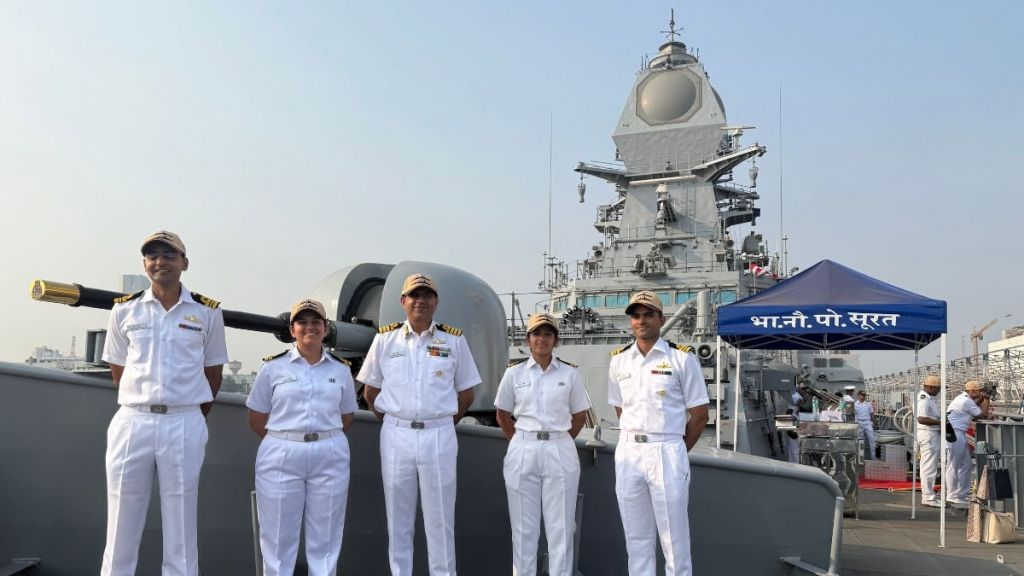
Mumbai: The induction of the three cutting-edge naval vessels INS Surat, INS Nilgiri and INS Vaghsheer has placed India firmly in the top three navies dominating the Indian Ocean Region and Indo Pacific Region providing significant boost to the Indian Navy combat potential. The commissioning of three combat platforms together is a a watershed moment in Indian maritime history.
The lead ship of the seven new stealth frigates under Project 17A, INS Nilgiri represents a significant advancement with new generation stealth technology.

Statement Of Commanding Officer Of INS Nilgiri Captain Nitin Kapoor
“It is equipped with modern aviation facilities and can operate multiple helicopter types, including the newly inducted MH-60R. The warship incorporates advanced features for enhanced survivability, seakeeping and stealth, reflecting the next generation of indigenous frigates,” said the beaming commanding officer of the newly minted warship INS Nilgiri captain Nitin Kapoor.
About The Stealth Frigate INS Nilgiri
The stealth frigate INS Nilgiri, dedicated to the maritime prowess of the Chola dynasty, is considered to be a major advancement over the Shivalik-class frigates and incorporates elements such as an enclosed mooring deck, a low infrared signature, a deck rail system for the safe movement of crew and material. The Infra-Red Suppression System reduces emissions from the ship’s propulsion exhaust and power generation machinery to avoid enemy radar detection.


About INS Surat
The fourth and final vessel of the Project 15B guided missile destroyer INS Surat is follow-on to the Kolkata-class destroyers constructed in record 31 months and ranks among the largest and most sophisticated destroyers in the world, making critical addition to the Indian Navy surface fleet.
“It has an indigenous content of 75% and is equipped with state-of-the-art weapon-sensor packages and advanced network-centric capabilities. It is among the largest and most sophisticated destroyers globally constructed in record 31 months. The beautiful warship is future ready and can take any role required to advance Indian maritime, economic and diplomatic interests,” said the INS Surat commanding officer captain Sandeep Shorey.
The Surat warship, reminiscent of the era when Gujarat's ports connected India to West Asia, with commissioned crew of 350 sailors and 30 officers is armed with surface-to-surface ‘BrahMos’ Supersonic cruise missiles and ‘Barak-8’ medium-range surface-to-air missiles (MRSAM), indigenous 76 mm Super Rapid Gun Mount, an anti-submarine weapon suite comprising an indigenous torpedo tube launcher and indigenous rocket launchers with advanced sensor suite providing a continuous multi-dimensional surveillance bubble around the ship
The predecessors of Surat in the Project 15B-class of guided missile stealth destroyers INS Visakhapatnam commissioner in November 2021, INS Mormugao commissioner in December 2022 and INS Imphal commissioned in December 2023 have played a vital role of force multiplier in the Indian Navy missions.
Both Nilgiri and Surat, have capabilities to operate a range of helicopters, such as the Chetak, ALHs (Advanced Light Helicopters), Sea King and the newly inducted MH60R even in darkness with accommodations to support women sailors and officers onboard.
About INS Vaghsheer
The sixth and last of the french design scorpene class submarine INS Vaghsheer boasts of high-tech periscope system gathering HD imagery for improved situational awareness with Thales sonar suite offering stealth, endurance and advanced firepower to challenge adversaries undetected underseas.
“The submarine was initially constructed in five separate sections. The welding of these five sections into one submarine— Boot Together— completed in 2021 and launched in 2022 is an record for the Indian Navy,” said INS Vaghsheer CO commander Vineet Sharma leading a lean submariners of 11 officers and 47 sailors to traverse the vast oceans undetected for several weeks without resurfacing for air and replenishments.
The indigenous diesel electric submarine fleet to replace the aging soviet era subs will add more fire power to the inspirations of the Indian Navy and represents India's growing expertise in submarine construction and has been built in collaboration with the Naval Group of France.
Indian Defence Establishment Welcomes The Addition
The Indian defence establishment welcomed the addition of the sixth and final submarine of the French Naval Group P75 Scorpene Project INS Vaghsheer but cautioned that Indian Navy submarine fleet is woefully short of the hostile neighbour Pakistan Navy three Agosta-90B class submarines equipped with French supplied Module d’Energie Sous-Marin Autonome advanced Stirling powered Air Independent Propulsion (AIP) system.
“While India will get the next submarine in 2032, Pakistan has a strategic lead in the Indian Ocean Region with 11 AIP equipped submarines in operations further expanding underwater strategic capabilities in the coming years along with eight Hangor class submarines from China,” explained a naval commander. The AIP system offers enhanced underwater endurance providing critical advantage to modern naval warfare.
The Indian Navy current fleet of diesel electric submarines includes INS Kalvari, INS Khanderi, INS Karanj, INS Vela and INS Vagir.